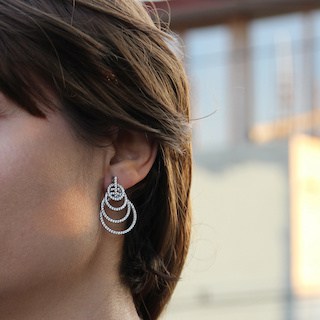Years ago I discovered what I have jokingly decided to call the “Pierced-Ears Principle.” The name comes from the story of what happened after I pierced my ears.
First, the background. As I was beginning to do more public speaking, I started working to improve my style — dress, haircut, makeup, accessories, wardrobe. I used to have a nerdy style, which matched my self-image as an engineer. But over time I decided that I wanted to look more feminine and I needed to look more polished as a member of the speaking profession.
I worked on this in fits and starts, with some progress but a lot of ups and downs. At some point during that journey, I concluded I should pierce my ears. Earrings are an important accessory, and I realized I would never get myself to wear clip-on earrings regularly. They’re just too uncomfortable. Six months later I finally got around to doing it.
And then a miracle occurred. I immediately started styling my hair every day. Soon after, I started putting on makeup every day. Within about two weeks, I was accessorizing my outfits every day. Within a month, I had changed my wardrobe to include many more dresses and a much more feminine, polished look. Shortly thereafter, I changed my haircut.
What happened? Every morning, I would look at the earrings in my ears and think, “Well, I have to do my hair.” After a few days, I found I would look at my hair and think, “I might as well put on makeup.” And then after doing that for a few days, I found myself thinking, “Shouldn’t I wear other jewelry in addition to the earrings?” And then, after a bit I thought, “Gee, this isn’t a flattering outfit, what else could I wear?”
I made one small change for the better, and it was an immediate catalyst for many other changes.
Around that time, the same pattern emerged in conjunction with buying a new dining table. The previous table was in a sorry state. It was faded. It had a cigarette burn that we had been unable to repair. It had many scratches courtesy of Mookie, our cat. The finish was gone in places. It was an embarrassment. We had to cover it with a tablecloth when company came.
We finally bought a replacement table. It was beautiful. It was smaller, so it didn’t feel crowded in the space. It had leaves we could put in to make it larger for special occasions. It was such a pleasure to have this new table that both my husband and I would spontaneously polish it with special furniture oil.
And, over the first few weeks we had it, a miracle occurred. We decluttered the living room. The table looked so nice we wanted to keep it clear. And then the other surfaces around it looked messy so we started clearing them, too. It was hard to figure out what to do with the stuff, so we had some shelves built next to the table — suddenly everything had a home. The stuff that didn’t have a home needed to go to my office — so we bought a new table for my office. Ta-Da! The living room looked great. Both my husband and I were motivated to keep it looking great thanks to that table.
What’s in common between these two cases? They both started with one small improvement. Why did that improvement have such an impact? Four things seem important:
a) The improvement was permanent. Once you pierce your ears, the earrings stay in for 10 weeks. Once you buy a new table, it’s there in the room every day.
b) The improvement was obvious. I saw the earrings in the mirror each morning. We saw the table in the living room.
c) The improvement made familiar things look worse by contrast. My hair looked bad with earrings. Clutter looked bad on the table.
d) There was always one obvious next improvement to make — never an overwhelming number.
In other words, the one change set up a virtuous cycle of improvement. One improvement led inexorably to the next. Can this pattern be replicated by design? I bet it can.
Piercing ears and buying a table are “enders,” tasks that, once done, are done. The other activities — doing hair, putting on makeup in the one case, or clearing up the table and living room in the other case — are “repeaters.” “Repeaters” have to be done again and again. (I got this distinction from Mark LeBlanc, a small business coach whom I recommend.)
The key to this virtuous cycle seems to be to find one small “ender” that will shake up the status quo so that you want to raise your standards. Doing the “ender” will then create a situation where you are repeatedly motivated to do the “repeaters” that are needed to follow through.
We could call it the “Dining-Table Principle,” but I like the “Pierced-Ears Principle” better.









0 Comments